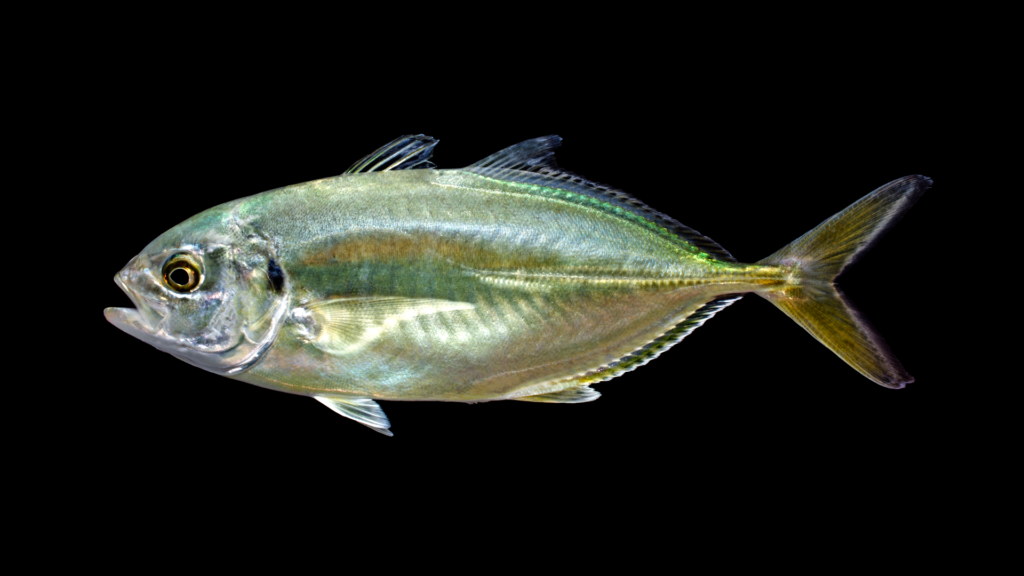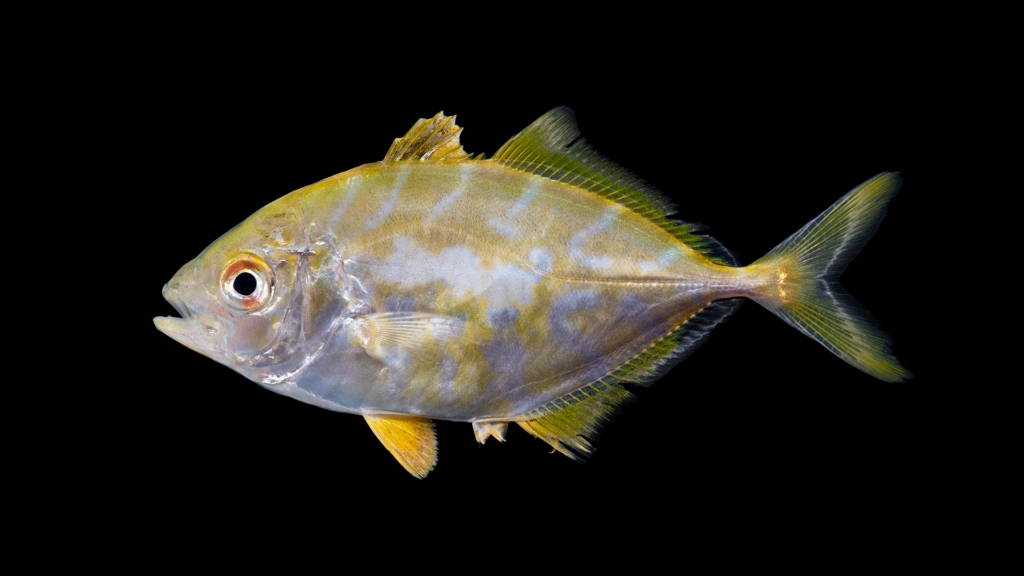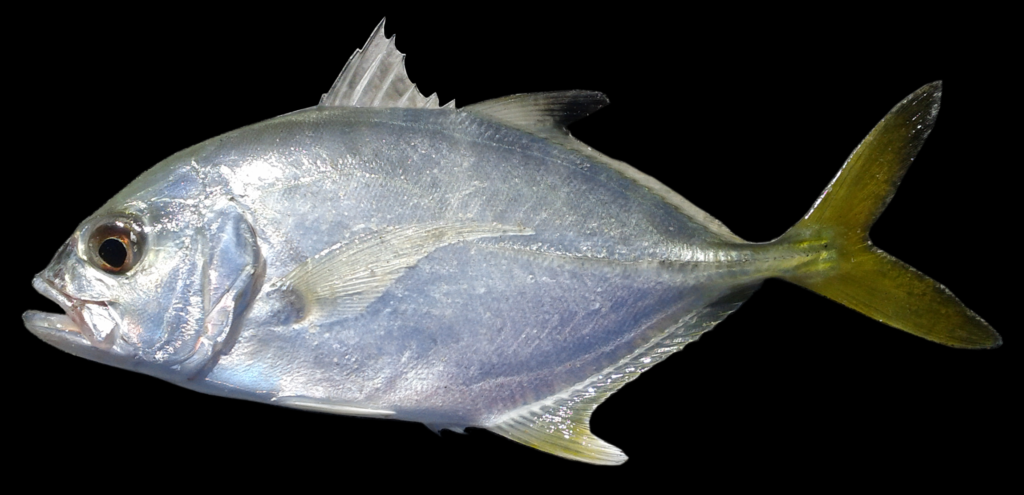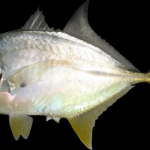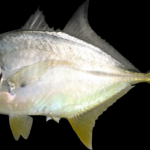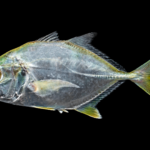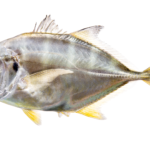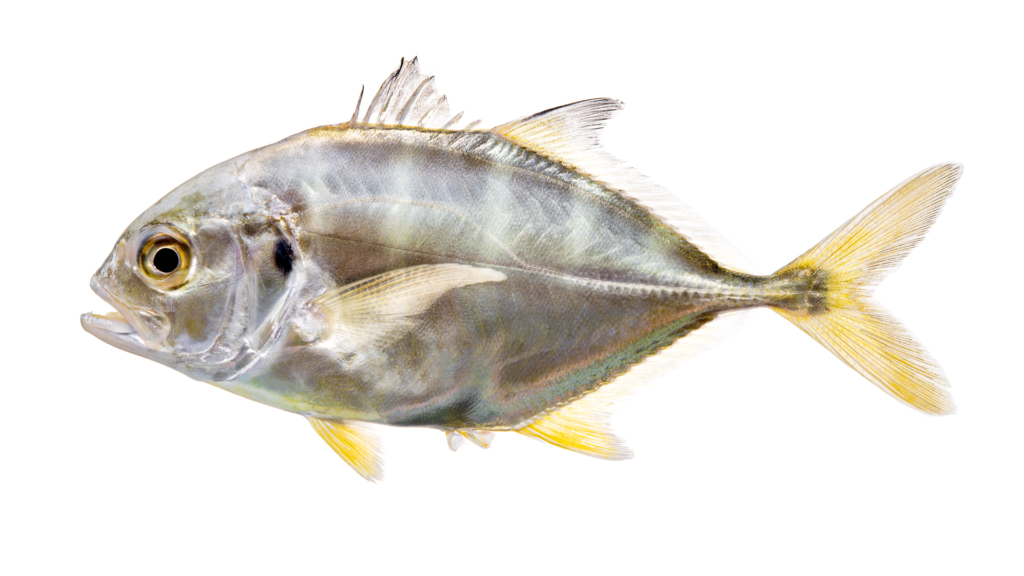
| Family | Scientific Name | Author | Year | Common Name |
| Carangidae | Caranx hippos | (Linnaeus) | 1766 | Jack Crevalle |
Caranx hippos
Unique Characters: Body deep, front of head steep. Body underparts and fins often yellow. Black spot at edge of opercle. Adults with oval black spot on pectoral fin. Posterior straight part of lateral line with enlarged hardened scutes. Scales obvious over most or all of body. Adults with pectoral fins relatively long and falcate, distinctly longer than head length. No black saddle on upper part of caudal peduncle. Scutes on straight part of lateral line 23-56, and relatively large (maximum height at least equal to pupil diameter). Body slightly to moderately compressed and ventral profile not more convex than dorsal profile. Anal fin spines distinct and movable. No scutes in posterior part of lateral line point forward. Lobe of second dorsal fin distinctly longer than height of longest dorsal-fin spine. Lips of adults not papillose. Upper jaw with several rows or a band of teeth; both caudal-fin lobes about equal in length. Caudal fin with paired keels. Chest naked except for a small patch of prepelvic scales.
Similar Species:
Bar Jack
Caranx ruber
Blue Runner
Caranx crysos
Bar Jack Caranx ruber. Body grayish blue with a black stripe that extends along the dorsum from first dorsal fin onto lower lobe of caudal fin. A pale blue stripe is present below the black stripe. Posterior straight part of lateral line with enlarged hardened scutes. Scales obvious over most or all of body. Adults with pectoral fins relatively long and falcate, distinctly longer than head length. No black saddle on upper part of caudal peduncle. Scutes on straight part of lateral line 23-56, and relatively large (maximum height at least equal to pupil diameter). Body slightly to moderately compressed and ventral profile not more convex than dorsal profile. Anal fin spines distinct and movable. No scutes in posterior part of lateral line point forward. Lobe of second dorsal fin distinctly longer than height of longest dorsal-fin spine. Lips of adults not papillose. Upper jaw with several rows or a band of teeth; both caudal-fin lobes about equal in length. Caudal fin with paired keels. Chest completely scaly; no oval black spot on pectoral fin. Lower gill rakers 31 to 38.
Blue Runner Caranx crysos. Body usually olive green to bluish. Black spot at tip of opercle. Arched part of lateral line short, Tips of caudal fin lobes black. Body slightly to moderately compressed and ventral profile not more convex than dorsal profile. Posterior straight part of lateral line with enlarged hardened scutes. Scales obvious over most or all of body. Adults with pectoral fins relatively long and falcate, distinctly longer than head length. No black saddle on upper part of caudal peduncle. Scutes on straight part of lateral line 23-56, and relatively large (maximum height at least equal to pupil diameter). Anal fin spines distinct and movable. No scutes in posterior part of lateral line point forward. Lobe of second dorsal fin distinctly longer than height of longest dorsal-fin spine. Lips of adults not papillose. Upper jaw with several rows or a band of teeth; both caudal-fin lobes about equal in length. Caudal fin with paired keels. Chest completely scaly; no oval black spot on pectoral fin. Lower gill rakers 25-28. No dark blue stripe extending along back and through lower caudal-fin lobe. Lateral-line scutes 46-56.
Yellow Jack
Caranx bartholomaei
Horse-eye Jack
Caranx latus
Yellow Jack Caranx bartholomaei. Body and fins with a yellowish cast. Young are brassy with many pale spots. Snout longer than eye, Arched part of lateral line low and smooth. Posterior straight part of lateral line with enlarged hardened scutes. Scales obvious over most or all of body. Adults with pectoral fins relatively long and falcate, distinctly longer than head length. No black saddle on upper part of caudal peduncle. Scutes on straight part of lateral line 23-56, and relatively large (maximum height at least equal to pupil diameter). Body slightly to moderately compressed and ventral profile not more convex than dorsal profile. Anal fin spines distinct and movable. No scutes in posterior part of lateral line point forward. Lobe of second dorsal fin distinctly longer than height of longest dorsal-fin spine. Lips of adults not papillose. Upper jaw with several rows or a band of teeth; both caudal-fin lobes about equal in length. Caudal fin with paired keels. Chest completely scaly; no oval black spot on pectoral fin. Lower gill rakers 16-21. No dark blue stripe extending along back and through lower caudal-fin lobe. Lateral-line scutes 22-39. Dorsal- and anal-fin rays 25-28 and 21-24, respectively
Horse-eye Jack Caranx latus. Body dark blue to bluish grey above, silvery white to golden below. Black spot on opercle often indistinct or absent. Posterior scutes often blackish. Upper dorsal may have some black as well as a black margin on yellow caudal fin. Posterior straight part of lateral line with enlarged hardened scutes. Scales obvious over most or all of body. Adults with pectoral fins relatively long and falcate, distinctly longer than head length. No black saddle on upper part of caudal peduncle. Scutes on straight part of lateral line 23-56, and relatively large (maximum height at least equal to pupil diameter). Body slightly to moderately compressed and ventral profile not more convex than dorsal profile. Anal fin spines distinct and movable. No scutes in posterior part of lateral line point forward. Lobe of second dorsal fin distinctly longer than height of longest dorsal-fin spine. Lips of adults not papillose. Upper jaw with several rows or a band of teeth; both caudal-fin lobes about equal in length. Caudal fin with paired keels. Chest completely scaly; no oval black spot on pectoral fin. Lower gill rakers 16-21. No dark blue stripe extending along back and through lower caudal-fin lobe. Lateral-line scutes 22-39. Dorsal- and anal-fin rays 19-23 and 16-19, respectively. Adults with upper jaw extending to vertical at rear margin of eye. Dorsal-fin lobe shorter than head, about 5.6-6.0 times in fork length.
Black Jack
Caranx lugubris
Black Jack Caranx lugubris. Body dark gray to blackish. Scutes and fins blackish. front of head straight and steep. Posterior straight part of lateral line with enlarged hardened scutes. Scales obvious over most or all of body. Adults with pectoral fins relatively long and falcate, distinctly longer than head length. No black saddle on upper part of caudal peduncle. Scutes on straight part of lateral line 23-56, and relatively large (maximum height at least equal to pupil diameter). Body slightly to moderately compressed and ventral profile not more convex than dorsal profile. Anal fin spines distinct and movable. No scutes in posterior part of lateral line point forward. Lobe of second dorsal fin distinctly longer than height of longest dorsal-fin spine. Lips of adults not papillose. Upper jaw with several rows or a band of teeth; both caudal-fin lobes about equal in length. Caudal fin with paired keels. Chest completely scaly; no oval black spot on pectoral fin. Lower gill rakers 16-21. No dark blue stripe extending along back and through lower caudal-fin lobe. Lateral-line scutes 22-39. Dorsal- and anal-fin rays 19-23 and 16-19, respectively. In life, head, body, and fins grey to dark brown. Adults with upper jaw extending to below vertical from anterior half to middle of eye. Dorsal-fin lobe longer than head, about 2.3-5.3 times in fork length.
Gallery

